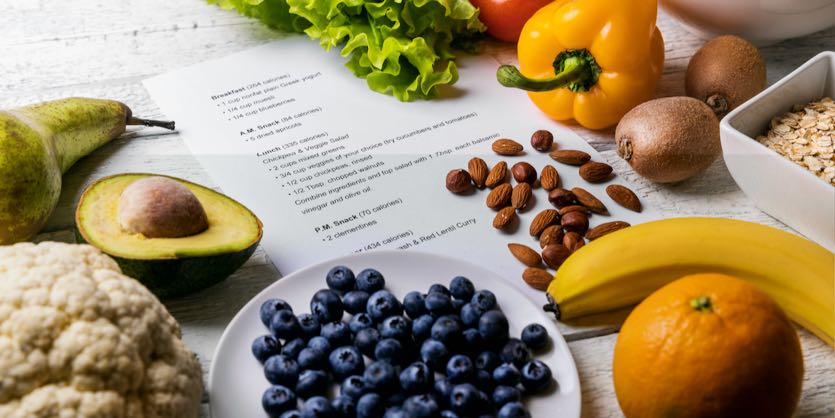The Skinny on Diets for Weight Loss

Dieting to lose weight has become a regular pastime for many adults. But, how is that working out? Not great. Studies show that within five years, 60 percent of dieters regain more weight than they lost on their diets.
If no diet seems to work well over time—according to the research—why are there so many? A quick search can pull up hundreds. It’s because even if you haven’t succeeded before, attaining and maintaining a healthy weight is a noble goal. And it’s one that can pay big health dividends.
Why Diets are Popular?
Weight management is one of the world’s biggest health issues. Worldwide obesity has nearly tripled since 1975. In the United States, 39.6 percent of adults are classified as obese. As of 2016, globally, 39 percent of adults were overweight and 13 percent were obese.
The reality of modern life is that most of the world’s population lives in countries where overweight and obesity kills more people than the problem of being underweight. And, it’s not just about food consumption. Less than five percent of U.S. adults participate in 30 minutes of physical activity each day. And only one in three adults receives the recommended amount of physical activity each week.
What is a Diet?

A general definition of diet is “the sum of energy and nutrients obtained from foods and beverages consumed regularly by individuals.” The fact that a diet is healthy or nutritious doesn’t necessarily make it ideal for weight control. So, this article will focus only on reduced-energy diets intended to shrink bodyweight and body fat.
The most basic and long-held principle of weight loss or gain is determined by either a calorie deficit or excess. You might know this as calories in/calories out, or caloric balance. The oversimplification of the caloric balance concept has led to a call to “eat less, move more” as a solution to the worldwide obesity problem.
While the caloric balance concept is ultimately true, it isn’t that simple and doesn’t account for the composition of weight gained or lost. Numerous factors influence eating behaviors and dictate energy intake (calories taken in). In addition, there are multiple factors tied to the “calories out” side of the equation (calories burned). This article only focuses on the diet, or “calories in” side of the equation.
And there’s plenty to discuss on that side of the equation. Below, you won’t find every popular diet available today—there are too many. Instead, you’ll see analysis of the major diet types, or concepts. Don’t worry, most common diets or brands will fall under one of the classifications discussed below.
With so many major diet types, conflicting information and new fads thrown at you constantly, how do you know which diet or eating pattern is the best? Take a look at the science behind these major diet types.
Low-Carbohydrate Diets
You’ve heard it before: carbs are just the worst. That statement may be a little too over the top. But there are plenty of diets that focus on limiting carbohydrates. Low-carb diets are a broad category that’s difficult to define precisely.
But let’s try. Official U.S. government guidelines suggest an intake of 45-65 percent of calories from carbohydrates. So, let’s define a low carb diet as a carbohydrate intake of 10-40 percent of total daily calories. (Carbohydrate intakes of 10 percent or less—or about 50 grams—result in elevated blood ketone bodies and changes in energy metabolism. These very low-carb diets deserve a separate discussion. So, you’ll read about ketogenic diets in the next section.)
Their popularity might make you expect the research about low carb to be outstanding. But studies comparing the effects of low-fat diets and low-carb diets have provided mixed results. That’s especially true with studies that use a more liberal definition of low-carb diets (less than 40 percent of calories from carbs). That research has shown little difference in body weight and waist circumference when comparing low-carb to low-fat diets.
But research comparing lower carbohydrate intake (less than 20 percent of calories) has favored low-carb diets over low-fat for weight loss and improvement of health risk factors.
A recent meta-analysis looked at the effect of low-carb diets on fat mass and body weight. The diets in the analysis were categorized as either mild low-carb (about 40 percent carbs) or very low-carb (about 10 percent carbohydrates). With all low-carb diets considered, the fat loss was greater with low-carb than the control diets.
And the lower carb, the better the results. When they compared each type of low-carb diet (mild and very low), the diet with just 10 percent carbs had significant difference compared to the control. The mild did not.
But it should be noted that the absolute difference in fat loss after 12 months between either of the low-carb diets and the control diets was only 0.57-1.46 kg. This small difference in results after a year is likely not very compelling for the average dieter.
Pros:
- Defaults to higher protein intake, which helps you feel fuller.
- Provides flexibility with regard to fat and protein intake.
- Does not indiscriminately prohibit foods based on fat content.
Cons:
- Significantly limiting carbohydrates may falsely convey the message that carbohydrates are solely responsible for weight gain.
- Limits healthy fruit, vegetable, whole grain, and legume servings in the diet.
Examples: Atkins, Dukan, Zone, South Beach diet, Stillman, Kimkins
Ketogenic Diets
If you have read anything about health and diet over the past couple of years, you’re probably familiar with the term “keto.”
The ketogenic diet (KD) is a variation of a low-carbohydrate diet, but different enough to earn a separate discussion. Unlike the rather liberal definition of low-carb diets in general, the keto diet is objectively defined by its ability to measurably elevate circulating ketone bodies or ketones. These are chemicals your body produces when it burns stored fat.
Entering this state of ketone elevation is also known as nutritional ketosis. And it’s important to distinguish it from diabetic ketoacidosis (DKA). DKA can be a life-threatening condition resulting from dangerously high levels of ketones and glucose (sugar) in the blood. This combination makes your blood too acidic. That can severely impact the function of organs like the liver and kidneys. Diabetic ketoacidosis occurs primarily in Type I diabetics and in the absence of insulin.
Nutritional ketosis can result from a very low-carb diet, fasting, or if you’ve consumed too much alcohol. If you’re in ketosis, you have a higher than usual level of ketones in your blood or urine, but not high enough to cause acidosis.
Now you know the difference between DKA and dietary ketosis. So, let’s focus on how to achieve the sweet spot for dietary ketosis. Aside from completely fasting, ketosis can be attained by restricting carbohydrates to less than 50 grams per day (or about 10 percent of energy intake). The typical ketogenic diet would be:
- 5-10 percent carbohydrates
- 15-20 percent protein
- 70-80 percent fat
It is important to mention that extreme carb restriction often results in unpleasant side effects at the beginning. Commonly known as the “keto flu,” many dieters experience fatigue, weakness, brain fog, headaches, irritability, and nausea. The time it takes to adapt to a keto diet is different for everybody. But after two-to-three weeks, most low-carb dieters report improved mental concentration, focus, and physical energy.
Keto advocates say the production of ketone bodies and a state of ketosis results in a unique metabolic state. It’s this state, they say, that helps keto diets do better than other diets at losing fat. But the scientific evidence for this assertion is mixed, at best.
The true test of the keto state happens when researchers match up the protein and energy intake between keto and non-keto diets. Experiments with this setup, with very few exceptions, have failed to show a fat-loss advantage with keto. This has been shown in the most controlled setting (where participants eat only what is given to them). In these strict studies, comparisons between keto and non-keto diets that have equal calories and protein have never reported significantly increased energy expenditure or greater loss of body fat with keto diets.
Two meta-analyses provided strong evidence against a metabolic advantage to near total carbohydrate restriction, like keto. The analyses included 32 studies, all of which were strictly controlled with all the food provided to the subjects. Carbohydrates ranged from one to 83 percent and dietary fat ranged from four to 84 percent of total energy. No metabolic or fat loss advantage was seen in the low-carbohydrate conditions. On the contrary, fat loss was slightly greater in the higher carb or low-fat condition.
Critics of the existing literature suggest that trials need to run longer to allow for sufficient “ketoadaptation.” This is a physical shift away from using sugar for fuel and toward an increase in fat as a primary fuel source. However, when objectively measured, the increased percentage of fat burned for fuel plateaus after about one week on a ketogenic diet. Simply put, rigorously controlled studies have shown ketoadaptation doesn’t necessarily amount to a net decrease in body fat.
If there is any advantage to keto diets for fat loss, it is potentially in the realm of appetite regulation. Even without calorie restrictions, keto has consistently resulted in body fat and/or body-weight reduction. That’s because fat and protein improve satiety, which helps keto dieters to eat fewer calories. Ketogenic diets also may increase satiety through a suppression of ghrelin production (a hormone that stimulates appetite). However, it remains unclear whether the appetite suppression is due to ketosis or other factors like increases in protein, or restriction of carbohydrates.
Pros:
- Defaults to higher protein intake.
- Suppresses appetite or controls hunger, even with no imposed calorie restrictions.
- Simplifies meal planning and dietary decision-making process.
Cons:
- Severely restricts fruit, vegetable, whole grain, and legumes, which are significant sources of fiber and nutrients in the diet.
- Can compromise high-intensity training output.
- Has not shown superior effects on body composition compared to non-keto diets when protein and calories are matched.
- Dietary extremes make it hard to stay on or stay compliant, long term.
Intermittent Fasting
You can probably guess how intermittent fasting diets work. It’s right there in the name. Intermittent fasting is where you cycle between periods of eating and fasting. That makes dieting less about which foods you should eat, and more about when you should eat them.
There are numerous variations of intermittent fasting. But it can be divided into three major subclasses: alternate-day fasting, whole-day fasting, and time-restricted feeding.
Alternate-day fasting is the most studied variation. You may have also heard it called The Every Other Day Diet. As the name suggests, alternate day typically involves switching between 24-hours of fasting and 24-hour feeding periods. The feeding day is not restricted by calories or food types.
Studies have shown that dieters do not eat enough on feeding day to offset the prior day’s fast. Over time, this leads to a calorie deficit and weight loss. Research has also shown that lean body mass is well conserved with this approach. A popular variation of the alternate day diet includes a small meal (fewer than 500 calories) on fasting day rather than zero calories. This variation may slow weight loss slightly, but seems to help further preserve lean body mass and improve compliance.
Whole-day fasting typically involves one or two 24-hour fasting periods throughout the week of otherwise normal eating. Like alternate day, variations to whole day include no-food fast days or those with 500-600 calories. Whole-day fasting has been shown to be as effective as daily calorie restriction for losing body weight and fat. (This was shown over a period of three to six months of similar weekly calorie deficit.)
Time-restricted feeding does just that—limiting the time you eat to several hours a day. Generally, that means a fasting period of 16-20 hours and four to eight hours of unrestricted eating. Until recently, little research has been done on these diets. Two recent studies using 20/4 and 16/8 fasting and feeding schedules in active individuals showed promise. They found the time restrictions lowered body fat while maintaining lean-body mass—compared to normal diet controls.
The largest review of intermittent fasting research found very similar results when comparing the effects of intermittent fasting to continuous calorie restriction. Body-composition change and other positive outcomes between the two diets were considered equivalent. However, intermittent fasting was considered superior at suppressing hunger.
Pros:
- All three forms of intermittent fasting have relatively strong evidence for performing equally or better than daily caloric restriction for improving body composition.
- Intermittent fasting diets have unrestricted eating cycles and precise calorie counting isn’t needed.
- Time-restricted feeding—combined with training—has emerging evidence for fat loss while maintaining strength.
Cons:
- Unhealthy food choices and excess calories can become part of the unrestricted feeding periods.
- If optimal athletic performance is a concern, intermittent fasting requires caution and careful planning.
- Extra considerations may be necessary with certain medical conditions, such as diabetes.
Examples: Every Other Day Diet, The 5:2 Diet
Low-Fat Diets
Low-fat diets typically provide 20–35 percent of calories from fat. This range is based on the Acceptable Macronutrient Distribution Ranges (AMDR) for adults set by the Food and Nutrition Board of the Institute of Medicine.
Since the 1950s, health professionals have promoted eating less fat to improve public health. Updated dietary guidelines have maintained these recommendations, and major health organizations—like the American Heart Association and the American Diabetes Association—support these guidelines. And, a strong base of scientific evidence supports low-to-moderate fat intake for health benefits.
Research has consistently shown that reducing fat intake below normal levels is helpful. It can lead to moderate, but consistent, weight loss, reduction in body fat, and decreased waist circumference. However, over the long-term, lower fat diets have not consistently resulted in greater weight loss than simply reducing overall calories.
The average adult in the U.S. consumes only 33 percent of their calories from fat. So, simply reducing fat intake slightly won’t likely be an effective strategy for most people eating a typical diet.
What about a more drastic reduction in fat? Getting only 10-20 percent of your calories from fat is considered a very low-fat diet. Limited amounts of research exist on diets that fit this profile. But the diets have consistently shown positive effects on weight loss and health.
Results change when very low-fat diets were compared with other diets of equal calorie intake. These studies analyzed body composition and showed no significant difference in body-fat reduction. Also, these very low-fat diets are difficult to maintain long-term. And studies that have instructed subjects to consume fat at 10-20 percent have revealed actual intakes around 26 percent.
Pros:
- Low-fat diets have the support of major health organizations. That’s because they have a large base of scientific evidence supporting their health effects.
- They allow flexibility with protein and carbohydrate intake.
- Does not indiscriminately vilify foods based on carbohydrate content.
Cons:
- May falsely convey the message that dietary fat is solely responsible for excess body fat.
- Increased intakes of carbohydrates often include unhealthy sugar and increased processed foods.
- Very low-fat diets are hard to maintain and lack enough solid evidence on body composition comparisons.
Examples: Lowfat: Volumetrics, DASH Very low-fat: Ornish, Pritikin
Meal Replacements and Low-Calorie Diets
A meal replacement diet is just what it sounds like. Meal replacement programs typically provide between 800 and 1,200 calories per day. That’s why they’re often called low-calorie diets.
These diets usually require substituting one or two meals per day, with an additional healthy, low-calorie meal. There are considerable variations between programs, but the goal is the same. You replace your regular meals with low-calorie shakes and snacks to reduce overall energy intake. This beneficial calorie imbalance results in weight loss.
Most meal replacement programs suggest replacing two meals per day initially. That starts dieters off with more rapid weight loss. Then they transition to one replacement per day as a maintenance routine. Many scientific trials have supported the feasibility of this strategy. But it’s usually a relatively short-term fix. So, long-term success also depends on improved dietary habits and lifestyle modifications.
Before swapping out your ordinary food for packaged shakes, snacks, and soups, there are a few things to consider about the quality of the products. They should provide a balance of macronutrients (proteins, carbohydrates, and fats), just like in a healthy meal.
Protein quantity and quality should be a primary concern. Aim for enough to provide the minimum daily recommended protein intake when added to your regular meal(s). A protein intake of 15-25 percent of total calories is generally accepted as safe in normally healthy adults. This would equate to 45-75 grams of protein on a 1,200-calorie-per-day diet.
The quality of the protein is also important. So, most meal-replacement shakes use dairy, soy, egg, or a mixture of plant proteins. This ensures the shake contains adequate levels of all the essential amino acids. A sufficient dosage of varied, high-quality protein will help conserve lean body mass (muscles and organs) during weight loss. For more information on protein, check out this page.
The amounts of carbohydrate and fat will vary significantly between different replacement products. Even though their specific dosages are less important than the protein, they’re still worth noting. The average adult already struggles to get the recommended intake of fiber (25-30 grams). So, the products should contain a beneficial amount of soluble and insoluble fiber.
The addition of some fat helps with satiety and improves the absorption of certain nutrients.
And, because you’re replacing meals, it’s important your meal replacement contains a mixture of vitamins and minerals. This helps account for nutrients in the food you replace. If not, a daily multivitamin can help you meet daily minimum recommendations.
The safest and most effective meal replacements contain an appropriate balance of micro- and macronutrients. That means adequate level of quality protein, low-to-moderate carbohydrate content (with significant amounts of fiber), some healthy fat, and a broad spectrum of vitamins and minerals.
Pros:
- The diets involve premade products that eliminate or minimize the need for cooking and planning.
- Can help break snacking and other mindless eating patterns.
- Meal replacement products can be found in just about every supermarket health-food aisle and pharmacy.
Cons:
- Lack of variety can affect compliance and long-term adherence.
- There is high variation in the quality of processed foods.
Examples: Slim Fast, USANA RESET, Medifast, Body for Life, Nutrisystem, Weight Watchers, Jenny Craig
Very Low-Calorie Diets
Very low-calorie diets are indeed very restrictive. They typically provide only 400–800 calories per day. Because of the extreme calorie restriction, they’re rarely the first treatment plan for weight loss.
These diets are typically commercially prepared liquids, although some plans include soups and bars. The purpose of the diet is to induce rapid weight loss (1.0–2.5 kg/week or 2–5 pounds per week) while preserving as much lean mass as possible. Very low-calorie diets are generally used in situations of extreme obesity and require medical supervision.
On this type of diet, all regular food consumption is replaced. But theses diets shouldn’t be confused with meal replacement products, which typically replace one or two meals per day. The replacements in very low-calorie diets are fortified with the full spectrum of essential micronutrients and appropriate levels of macronutrients. The macronutrient content is approximately:
- Protein: 70-100 grams per day
- Fat: 15 grams per day
- Carbohydrates: 30-80 grams per day.
Dieters using these programs report weight loss that’s 75 percent fat and 15 percent lean mass. Resistance training can help preserve muscle during a very low-calorie diet, especially in untrained obese subjects.
In obese populations, aggressive caloric restriction is a potentially powerful intervention. The greater initial weight loss is associated with greater long-term success in weight-loss maintenance. (That shows the importance of a strong start for dieters.) But some research has found these diets don’t result in greater long-term (one year or more) weight loss than diets of 800-1,200 calories per day.
Although very low-calorie consumption can be the best suited for certain situations, it should be done with professional assistance. Poor quality protein and inadequate medical supervision can lead to disastrous results. Possible side effects include excessive loss of lean mass, cold intolerance, fatigue, headache, dizziness, muscle cramps, and constipation. Hair loss has also been noted as a common complaint.
Pros:
- Can induce rapid weight loss (1.0–2.5 kg/week or 2–5 pounds per week).
- The diets generally involve premade products that eliminate or minimize the need for cooking and planning.
Cons:
- Very low-calorie diets have a higher risk for more severe side-effects, but don’t necessary outperform low-calorie diets in the long-term.
- Should be done under the supervision of a medical professional.
- Very low-calorie diets have limited relevance to healthy and athletic people.
Examples: Optifast, KicStart, Optislim, Proslim
And the Winner Is?
If you are uncertain or confused about which diet or diet type is best for weight loss, that’s OK. Because there isn’t really a winner.
The various diet subtypes are wide-ranging in what and how much you can eat. Each type carries varying degrees of supporting data, and unfounded claims. In the end, though, long-term diet studies don’t support a significant difference between diet types. When calorie count is equal, the ability to reduce body fat is pretty much equal, too.
Each diet type has potentially unique means by which they can achieve the intended objective (i.e., improving satiety, ease of compliance, reducing hunger, etc.). But there’s a common thread that runs through all of the diets. And it’s a sustained reduction in calories eaten relative to calories burned. Diets may get there in different ways, but they’re all ultimately based on energy balance.
What Diet Should You Choose?
It comes down to what works for you. There are numerous subtypes that fall under the major diet categories above. But most diets focused on fat loss work the same—through calorie deficits. With adequate protein levels, it makes little difference whether the calorie deficit is due to a reduction in fat, carbs, or improved portion control. It also seems to make little difference whether you reduce calories daily and consistently, or by alternating fasting and unrestricted days over the course of a week.
The long-term success of the diet depends upon how well you can stick to it over time. Your chance of success is significantly better if you choose a diet with these four things:
- Fits your general food preferences
- Controls your hunger
- Supports your activity level
- Fits your lifestyle
If you need to lose weight, choose a diet that works for you, focus on health, and sticking to it. Even modest weight loss of five to 10 percent of your total body weight, can result in health benefits. These include improvements in blood pressure, blood cholesterol, and blood sugars.
You may need to purchase some new clothes, but that’s a side effect you will likely be fine with.
Characteristics of the Major Diet Subtypes
| Diet | Composition | Strengths | Limitations |
| Low-carbohydrate diets (LCD) | 50–150 g carbs, or up to 40% of kcals from carbs | Defaults to higher protein intake, which helps you feel fuller.
Provides flexibility with regard to fat and protein intake. Does not indiscriminately prohibit foods based on fat content. |
Significantly limiting carbohydrates may falsely convey the message that carbohydrates are solely responsible for weight gain.
Limits healthy fruit, vegetable, whole grain, and legume servings in the diet. |
| Ketogenic diets (KD) | 5-10% (less than 50 grams) carbohydrates
15-20% protein 70-80% fat |
Defaults to higher protein intake.
Suppresses appetite or controls hunger, even with no imposed calorie restrictions. Simplifies meal planning and dietary decision-making process. |
Severely restricts fruit, vegetable, whole grain, and legumes, which are significant sources of fiber and nutrients in the diet.
Can compromise high-intensity training output. Has not shown superior effects on body composition compared to non-keto diets when protein and calories are matched. Dietary extremes make it hard to stay on or stay compliant, long term. |
| Low-fat diets (LFD) and very low-fat diets (VLFD) | LFD: 25–30% fat
VLFD: 10–20% fat |
Low-fat diets have the support of the major health organizations. That’s because they have a large base of scientific evidence supporting their health effects.
They allow flexibility with protein and carbohydrate intake. Does not indiscriminately vilify foods based on carbohydrate content. |
Upper limits of fat allowance may falsely convey the message that dietary fat is solely responsible for excess body fat.
Increased intakes of carbohydrates often include unhealthy sugar and increased processed foods. Very low-fat diets are hard to maintain and lack enough solid evidence on body composition comparisons. |
| Intermittent Fasting (IF) | Alternate-day fasting (ADF): alternating 24-hour fast, 24-hour feed.
Whole-day fasting (WDF): 1–2 complete days of fasting per week. Time-restricted feeding (TRF): 16–20-hour fast, 4–8-hour feed, daily. |
All three forms of intermittent fasting have relatively strong evidence for performing equally or better than daily caloric restriction for improving body composition.
Intermittent fasting diets have unrestricted eating cycles and precise calorie counting isn’t needed. Time-restricted feeding combined with training has emerging evidence for fat loss while maintaining strength. |
Unhealthy food choices and excess calories can become part of the unrestricted feeding periods.
If optimal athletic performance is a concern, intermittent fasting requires caution and careful planning. Extra considerations may be necessary with certain medical conditions, such as diabetes. |
| Low-Calorie Diets (LCD) with
Meal Replacements |
Balanced macronutrients –
800-1,500 kilocalories (Kcal) per day |
The diets involve premade products that eliminate or minimize the need for cooking and planning.
Can help break snacking and other mindless eating patterns. Meal replacement products can be found in just about every supermarket health-food aisle and pharmacy. |
Lack of variety can affect compliance and long-term adherence.
There is high variation in the quality of processed foods. |
| Very Low-Calorie Diets (VLCD) | VLCD: 400–800 kcal/day | Can induce rapid weight loss (1.0–2.5 kg/week or 2–5 pounds per week).
The diets generally involve premade products that eliminate or minimize the need for cooking and planning. |
Very low-calorie diets have a higher risk for more severe side-effects, but don’t necessary outperform low calorie diets in the long-term.
Should be done under the supervision of a medical professional. Very low-calorie diets have limited relevance to healthy and athletic people. |
References
List of diets – Wikipedia. Retrieved September 27, 2018, from https://en.wikipedia.org/wiki/List_of_diets
(2018, March 23). Trends in Obesity and Severe Obesity … – The JAMA Network. Retrieved September 27, 2018, from https://jamanetwork.com/journals/jama/fullarticle/2676543
(2017, October 13). Prevalence of Obesity Among Adults and Youth – CDC. Retrieved September 27, 2018, from https://www.cdc.gov/nchs/products/databriefs/db288.htm
(n.d.). Clinical Guidelines – National Heart, Lung, and Blood Institute – NIH. Retrieved September 27, 2018, from https://www.nhlbi.nih.gov/files/docs/guidelines/ob_gdlns.pdf
(n.d.). Dietary Guidelines – Center for Nutrition …. Retrieved September 27, 2018, from https://www.cnpp.usda.gov/dietary-guidelines
(2011, November 8). Healthy People 2010 – CDC. Retrieved September 27, 2018, from https://www.cdc.gov/nchs/healthy_people/hp2010.htm
(n.d.). Medicare’s search for effective obesity treatments: diets … – NCBI – NIH. Retrieved September 27, 2018, from https://www.ncbi.nlm.nih.gov/pubmed/17469900
(2011, August 9). Does dieting make you fat? A twin study. – NCBI – NIH. Retrieved September 27, 2018, from https://www.ncbi.nlm.nih.gov/pubmed/21829159
(2018, February 16). Obesity and overweight – World Health Organization. Retrieved September 27, 2018, from http://www.who.int/news-room/fact-sheets/detail/obesity-and-overweight
Meal Replacements and Low-Calorie Diets
- https://www.ncbi.nlm.nih.gov/pubmed/20443094?dopt=Abstract
- https://onlinelibrary.wiley.com/doi/abs/10.1038/oby.2006.146
- https://link.springer.com/article/10.2165%2F00007256-199112040-00003
- https://www.ncbi.nlm.nih.gov/pubmed/12704397?dopt=Abstract
- https://www.ncbi.nlm.nih.gov/pubmed/20222968?dopt=Abstract
Low-Fat Diets
- http://dro.dur.ac.uk/17377/1/17377.pdf
- https://www.ncbi.nlm.nih.gov/pubmed/3687822?dopt=Abstract
- https://www.ncbi.nlm.nih.gov/pubmed/2021123?dopt=Abstract
- https://www.ncbi.nlm.nih.gov/pubmed/25398750?dopt=Abstract
- https://www.ncbi.nlm.nih.gov/pubmed/18444133?dopt=Abstract
- https://www.ncbi.nlm.nih.gov/pubmed/22098806?dopt=Abstract
- https://www.ncbi.nlm.nih.gov/pubmed/17341711?dopt=Abstract
- https://www.ncbi.nlm.nih.gov/pubmed/26138004?dopt=Abstract
- https://www.ncbi.nlm.nih.gov/pubmed/22258266?dopt=Abstract
Low-Carbohydrate Diets
- https://www.ncbi.nlm.nih.gov/pubmed/21985780?dopt=Abstract
- https://www.ncbi.nlm.nih.gov/pubmed/15356006?dopt=Abstract
- https://www.ncbi.nlm.nih.gov/pubmed/27059106?dopt=Abstract
Ketogenic Diets
- https://www.ncbi.nlm.nih.gov/pubmed/17684196?dopt=Abstract
- https://www.ncbi.nlm.nih.gov/pubmed/24557522?dopt=Abstract
- https://www.ncbi.nlm.nih.gov/pubmed/28074888?dopt=Abstract
- https://www.sciencedirect.com/science/article/pii/S001650851730152X
- https://insights.ovid.com/crossref?an=00124278-900000000-96026
- https://www.ncbi.nlm.nih.gov/pubmed/27385608?dopt=Abstract
- https://www.ncbi.nlm.nih.gov/pubmed/22935440?dopt=Abstract
- https://www.ncbi.nlm.nih.gov/pubmed/27903520?dopt=Abstract
- https://www.ncbi.nlm.nih.gov/pubmed/12218745?dopt=Abstract
- https://www.ncbi.nlm.nih.gov/pubmed/18175736?dopt=Abstract
- https://www.ncbi.nlm.nih.gov/pubmed/26553488?dopt=Abstract
Intermittent Fasting
- https://www.ncbi.nlm.nih.gov/pubmed/26374764?dopt=Abstract
- https://www.ncbi.nlm.nih.gov/pubmed/24215592?dopt=Abstract
- https://onlinelibrary.wiley.com/doi/abs/10.1002/oby.21581
- https://www.nature.com/articles/ijo2010171
- https://www.ncbi.nlm.nih.gov/pubmed/27737674?dopt=Abstract
- https://www.ncbi.nlm.nih.gov/pubmed/26384657?dopt=Abstract
Conclusion
Long-term weight loss maintenance for obesity: a multidisciplinary approach (Feb 2016)













